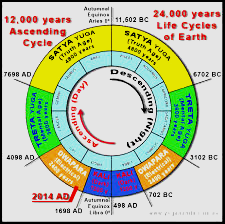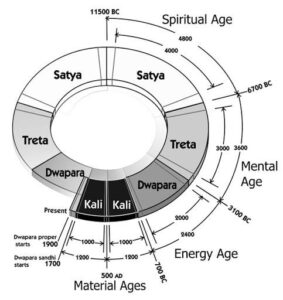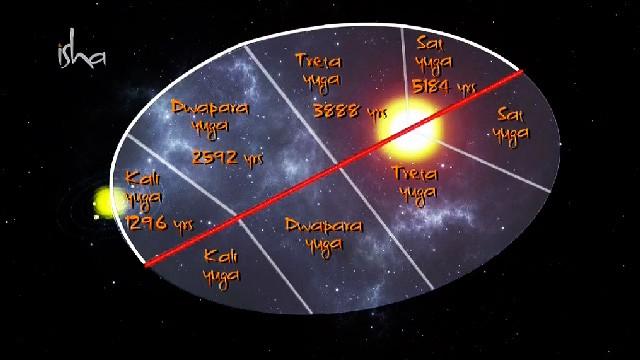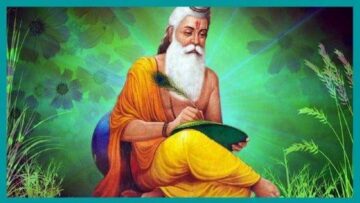Time is known as kālā in Indian philosophical systems. The syllable ‘kā’ refers to expansion of the universe and ‘la’ refers to ‘laya’ or contraction or reaching the place from where the things came. The Hindu time concept has got the following aspects:
- The universe and all creation in the universe are subjected to creation (sṛṣṭi) and destruction (laya).
- The universe itself is subject to expansion and contraction.
- The creation and destruction (sṛṣṭi and laya) are cyclical and permanently repetitive.
- Each phenomenon of the universe is set to differential time scale – from micro to macro.
- The changes in the universe are natural. Often order is restored by a supernatural force or God, who is referred to as Nārāyaṇa, Śiva or Brahmam.
The word ‘yuga’ is derived from two roots, ‘yu’ -’to join’ and ‘ga’- ‘ to move’. The time flows and joins all incidents and phenomena in the universe. In India time is usually classified into three categories – micro, meso and macro:
(i) Micro Time
1 lava= time taken to pierce a lotus leaf
1 mātrā = 256 lava
1 bindu = ½ matra 126 lava
1 ardha chandra = ¼ matra 64 lava
1 rodhinī = ⅛ matra 32 lava
1 nāda = 1/16 matra 16 lava
1 nādānta = 1/32 matra 8 lava
1 śakti = 1/64 matra 4 lava
1 vyāpika = 1/128 matra 2 lava
1 samana = 1/256 matra 1 lava
1 unmaṇī = less than 1/256 lava no time scale
This time scale is evolved by tantrics based on personal spiritual experience.
(ii) Meso Time
Meso time scale is manuṣya varṣa or human time scale we are experiencing in our life. The sub divisions in the meso time scale are real and measurable by instruments.
15 nimeṣa = 1 kāṣṭa
30 kāṣṭas = 1 kalā
30 kalās = 1 kṣaṇa
12 kṣaṇas = 1 muhūrta
30 muhūrtas = 1 ahorātra (1day time and 1 night time = 1 dana)
15 diva = 1 pakṣa
2 pakṣas = 1 māsa
6 māsas = 1 ayana
2 ayanas = 1 manuṣya varṣa (human year-the time taken for
one revolution of earth around our Sun)
(Viṣṇu Purāṇa, I. 3. 8-10ab):
काष्टा पञ्चदशख्याता निमेषा मुनिसत्तम । काष्ठास्त्रंशत्कला तास्तु त्रिंशन्मौहूर्तिको विधिः।
तावत्संख्यैरहोरात्रं मुहूर्त्तैर्मानुषं स्मृतम् । अहोरात्राणि तावन्ति मासः पक्षद्वयात्मकः॥
तैः षड्भिरयनं वर्ष द्वेऽयने दक्षिणोत्तरे ।
(iii) Macro Time
Kali Yuga = 4,32,000 manuṣya years (solar years).
Dvāpara Yuga = 8,64,000 manuṣya varṣa
Tretā Yuga = 12,96,000 manuṣya varṣa
Kṛta Yuga = 17,20,000 manuṣya varṣa
1 Catur Yuga or Mahā Yuga = 43,20,000 manuṣya varṣa
71 Catur Yugas 43,20,000 x 71 = 1 Manvantara
14 Manvantara = 1 Kalpa (one day time of Brahma
Sama time (14 Manvantara ) = one night time of Brahma
1000 Catur Yugas = 1 Kalpa = 4.32 billion solar years
360 x 2 x100 = Kalpas = lifetime of Brahma
Note:
- The time scale of 4 Yugas Kali, Dvāpara, Tretā and Kṛta are: 1:2:3:4 respectively.
- In this 4,00,000; 8,00,000; 12,00,000; and 16,00,000 years respectively
are the time duration of the four Yugas and the rest of the period is divided into two halves of ‘amśa’ and ‘sandhi’ periods i.e. 32,000, 64,000, 96,000 and 1,20,000 years respectively . - Kṛta yuga is also referred to as Satya Yuga.
There is another way of expressing the same macro time:
1 human year (365 days) = one day = ahorātra for Devas
360 ahorātras of Devas = 1 Devamāna or 1 Deva Varṣa or Divya varṣa
12000 Deva varsa = 1 Catur Yuga/ Maha yuga (43.2 lakh human years)
71/72 Catur Yugas = 1 Manvantara =1 Manu’s life time
14 Manvantaras /1000 Catur Yugas = 1 Kalpa (one day time of Brahma)
2 Kalpas = 1 day (ahoratram ) of Brahma
360 days of Brahmā = 1 year of Brahmā
100 years of Brahmā = 1 Brahmā’s lifetime
Today Brahma is 50 years old and he is in the first day of his 51st year.
Note:
In the long time scale, for easy understanding, rounding of the years is adopted by the Ṛṣis in Purāṇas. For example, we have 365.24636246 days per year which is the exact time taken for one revolution of the earth around the Sun. i.e. one day refers to a little over 1 degree movement of earth on its revolutionary orbit. However, one Deva Varṣa or divine year, is rounded off to 360 human days only. Taking this as a base, the time duration for Yugas are again rounded off. This is only for easy calculation and simplification. While defining the period of Manvantara, sage Vyasa says in Bhāgavata Purāṇa as follows (III. 11. 24):
स्वं स्वं कालं मनुर्भुङ्क्ते साधिकां ह्येकसप्ततिम् ।
मन्वन्तरेषु मनवस्तद्वंश्या ऋषय: सुरा: ।
भवन्ति चैव युगपत्सुरेशाश्चानु ये च तान् ॥
That is, a Manvantara has the time duration which is a little over 71 Catur Yugas. Some scholars round this as 72 Catur Yugas. 14 Manvantaras make one Kalpa. If we take a Manvantaras consisting of 71 Catur yuga for a Kalpa, it would be 994 Catur Yugas (14×71). Alternatively, if we take a Manvantara as consisting of 72 Catur Yugas, a Kalpa would be 1008 Catur Yugas (14×72). In order to reconcile the differences, the Purāṇas take middle way of rounding off and say that a kalpa consists of 1000 Catur Yugas.
INDIAN YUGA CYCLES
We said that Indian time scale is spiral, cyclical and permanently repetitive. India from ancient period had given freedom of thought and expression in all fields. Different religions in India had viewed time in different manners. Within Hinduism too, we find various schools which have measured and have adopted various time concepts and they are coexisting till date. Each time scale/Yuga scale serves a different purpose. Here we can see some important Yuga systems now prevalent in India and their applications.
THE FIVE-YEAR YUGA CYCLE
The concept of five-year Yuga cycle, namely, Samvatsara, Paritvatsara, Iḍāvatsara, Anuvātsara, Iḍāvatsara (Vatsara) is prevalent from Vedic times. (Taittirīya Brāhmaṇa III. 10 4. 1):
संवत्सरोऽसि परिवत्सरोऽसि इडावत्सरोऽसि अनुवत्सरोऽसि इड्वत्सरोऽसि … ।
Vajasaneya Samhita, 27.75; Taittriya Aranyka 4.19; and Satapatha Brahmana 8.1.48 also repeat this idea. This is known as Māgha cycle of Vedāṅga Jyotiṣa of sage Lagada (around 1350 BCE). He has written the text to help the Ṛṣis to perform Vedic rituals in proper seasons (Vedanga Jyotisa, I. l):
पञ्चसंवत्सरमयं युगाध्यक्षं प्रजापतिम् ।
दिनर्त्वयनमासाङ्गं प्रणम्य शिरसा शुचि: ॥
The five-year Yuga cycle starts with the asterism Śraviṣṭā in the month
of Māgha when the northern movement of Uttarāyana begins; hence the
term Māgha cycle. In this short Yuga cycle, a particular deity is considered as adhi-devatā of each year and in charge of different rituals. Bṛhat Samhitā 8.24 : 8.25 gives details about the five-year Yuga cycle and the respective rainfall regime.
In the Bhāgavata Purāṇa after explaining the human time scale, the five
year Yuga cycle is enumerated (III. 11. 14) :
संवत्सर: परिवत्सर इडावत्सर एव च ।
अनुवत्सरो वत्सरश्च विदुरैवं प्रभाष्यते ॥
Radhacharana Goswami, the commentator, explains the sloka thus “Samvatsara consists of one Solar year; Parivatsara is a yearlong stay of Jupiter in one house; Iḍāvatsara refers to financial year (30 days x 12 months) ; Anuvatsara refers to 12 Cāndra māsas and Vatsara is 12 nakṣatara months (movement of moon in 27 stars). More over the five year Māgha cycle merge with the 60 Jupiter cycle.
THE LONG AND SHORT YUGA CYCLES
There are two types of Yuga cycles recognised in India: One, the long time cycle (43,20,000 years in one Mahā Yuga/ Catur Yuga) and the other, the short Yuga cycle (12,000 years in a Maha Yuga). Actually the Purāṇas recognize only the long time scale. Purāṇas like Viṣṇu, Bhāgavata, Matsya, Mārkaṇḍeya etc. elaborately describe the divisions in the long time scale and various events happened in different periods. In some places where not many details are required to be elaborated, where Yuga definition is brief or cursory, they refer the Yugas and Mahā Yugas in Deva Varṣa or Divya Varṣa which is smaller and it is 12000 years (43,20,000/360= 12,000). Neither in Vedas, nor in Itihasas, nor in Purāṇas exclusively the short time scale is used to describe all events. Based on this long scale only we have numbered the present Kali age and our present Kali Year is 5121. This numbering system is still in vogue in saṅkalpa of rituals both at home and at religious functions: In all places from the Himalayas in the North to Kanyakumari in the South, Rajasthan in the West to Arunachal Pradesh in the East. Moreover, even people who are living in different continents outside India wish to know their respective zonal reference, so that they can continue to chant the saṅkalpa mantras in their respective new places. To this extent even today, the long time scale is ingrained in the consciousness of Indian people.
MERITS OF LONG TIME SCALE YUGA SYSTEM
- Among the Indian sacred texts, The Vedas are the earliest texts which provide ideas on creation of earth and many geography related ideas of ancient India. The Itihāsas talk about the historical and geographical conditions of their respective contemporary periods The Purāṇas are said to fulfil fivefold objectives : creation, secondary creation and destruction of worlds, the dynasties, information about manvantaras and the events transpired during those periods and genealogies (of kings and others):
सर्गश्च प्रतिसर्गश्च वंशो मन्वन्तराणि च ।
सर्वेप्वेतेषु कथ्यन्ते वंशानुचरितं च यत् ॥
In fact, many Purāṇas go beyond these fivefold objectives and deal with multiple subjects like astronomy, medicine, climatology, pilgrimages, austerities, dāna and host of other subjects. By their sheer volume they deal with these
subjects elaborately. They are also great historical chronicles. Many scholars like
H. H. Wilson, F.E. Pargiter, Alexander Cunnuingham and others have suggested that the Purāṇas are fit to be used in writing Ancient Indian History. Periodically they are updated and presented to people all over India by Paurāṇikas. Though the texts are essentially written in Sanskrit, Paurāṇikas took them to every home in India and even illiterates were well versed in Puranic information.
There are 18 Major Purāṇas (Mahā Purāṇas) and many minor Purāṇas (Upa Purāṇas). The major Purāṇas are: Viṣṇu, Bhāgavata, Garuḍa, Nārada, Padma, Varāha, Matsya, Kūrma, Śiva, Vāyu, Linga, Skanda, Agni, Brahma, Brahmāṇḍa, Brahma Vaivartaka, Mārkaṇḍeya, Bhaviṣya and Vāmana. Among the minor Purāṇas, Nṛsimha, Saura, Kālikā, Devī Bhāgavata etc. are important.
- Avatāras of Viṣṇu:
Out of 22 avatāras of Lord Viṣṇu given in Purāṇas, 10 are considered to be principal avatāras (Mukhya avatāra) and they are usually known as ‘daśāvatāra of Viṣṇu’. They are Matsys, Kūrma, Varāha, Narasimha, Vāmana, Paraśu Rāma,
Rāma Balarama, Krishna and Kalki. Out of the ten Principal avatāras, the first four in
the order, have part human and part non human form. They are not born as
latter avatāras do. They appear and disappear whenever the need arises. Hence,
H. H. Wilson, F. E.Pargiter, Colbrooke and others who have translated the Purāṇas call them as ‘divine avatāras’. According to Vāyu Purāṇa, Viṣṇu was cursed by Maharishi Bṛghu to take seven human births and suffer, as he killed the Maharishi’s wife. These latter six avatāras are called ‘human avatāras’. By seeing this order of principal avatāras many suppose that our ancients had a clear idea of evolution of species as propounded by Darwin. Dr. Jayasree Saranathan, an independent Indic scholar, disagrees with the idea and states the order has no connection to evolution. Moreover, in each Purāṇa the first avatāra of Viṣṇu, which usually happens during the Pralaya (just before fresh sṛṣṭi process), can be one among the four divine avatāras. Thus, we find the first avatara mentioned in Bhāgavata and in Viṣṇu Purāṇas is Varāha avatāra whereas in Matsya Purāṇa it is Matsya avatāra.
However, the daśāvatāras of Viṣṇu have notable significance in many respects. In Bhāgavata, Viṣṇu and in Matsya their time frame of occurrence spread to a Kalpa is 4.2 billion years. In Kūrma and Vāyu Purāṇas, the seven principal human avataras (and minor avataras like Kapila, Dattatreya etc.) are distributed over a time span of one Manvantara (Vaivasvata Manvantara in particular) period which is about 306 million years. Again Vāyu, Kūrma and others mention that, among the ten principal avatāras, the Matsya, Kūrma, Varāha, and Narasimha, occurred during the present Kṛta Yuga, Vamana, Parasurama and Rama avatāra during the Tretā Yuga; Balarama and Krisna avatāra during the present Dvāpara and the Kalki Avatar is yet to take place in the present Kali Yuga end. In Purāṇas the daśāvataras span over the period of a Kalpa, throw a lot of light on geological changes of our earth, evolution of species, and mass extinction of species (pralaya), making and breaking of continents etc. These natural cataclysmic changes mostly take place slowly over a long period of time (in millions and billion years). The second category is well suited for the study of evolution of human beings and societies. In the third group the Purāṇas like Yuga, Bhaviṣya, Kālikā, parts of Vāyu, Brahmavaivartaka, end portions of Bhāgavata and Viṣṇu cover changes in landscapes in and around India are largely covered, along with population and urban growth during the recent Tretā Yuga and Dvāpara and post Dvāpara age. In other Words, they cover the Geography of India during and post epic periods of India.
- The concept of Pralaya:
The sṛṣṭi and pralaya are the two extremes of one phenomenon. The elemental sṛṣṭi (samasti srsti) takes place at the beginning of the Kalpa. Subsequent life srsti (vyasti sṛṣṭi or vyakti sṛṣṭi), takes place at great intervals of time. Pralaya takes place usually at a great interval of time, like at the end of the Yuga, Catur Yuga, Manvantara and at the end of the Kalpa. Manvantara Pralaya and Kalpa Pralaya are very severe and result in the large-scale destruction of life on earth. The long time scale helps us to understand clearly the cataclysmic changes our earth undergoes periodically.
- The night of Brahmā:
The mass proliferation and extinction of species happen on earth at long intervals of time. The natural scientists show the mass extinction of species which happened about 600 million years ago as an example. Similarly the dinosaurs disappeared some 62 million years ago. Geologists and natural scientists explain how the process would have taken place. The Earth was covered with CO2 and sulphur gases in the beginning. Later when water was added to the planet, they settled at the bottom of the oceans. Today in many parts as high as 70,000 to 1,00,000 penta tons (1 penta ton= 1 billion tons) of CO2, CO and methane are trapped. At a long interval of time, at the bottom of the oceans earthquakes will begin accompanied by volcanism in the trenches and oceanic volcanoes. This will trigger the greenhouse gases trapped at ocean bottoms. Then the ocean’s turbidity currents at the bottom slowly go round and round as coils of great serpents and mix the deadly gases with ocean water, first at lower level and slowly upward. Thus, in 5000 years the ocean’s average temperature will rise 6 to 10 degrees, killing all species in the ocean. Then further the gases come outside the ocean towards land and continue the process of destruction. In the next 10,000 years most of the species on land will perish. Even after life is lost both in the ocean and on land, the processes will continue for millions of years. Then, when the pressure from the ocean bottom reduces, the process will slow down and stop. It will take a long time for earth to make the gasses settle down once more at the bottom of the ocean. Even then the earth has to wait for a long time to create a favourable condition for evolution of new species once more.
The night of Brahma is an excellent concept well defined in the Purāṇas.
The sṛṣṭi to Pralaya makes one day time of Brahmā, called Kalpa. Purāṇas specifically state that there is a period called Brahmā’s night and its duration is equal to day time of Brahmā.
“ The lifetime of Brahma is one hundred years: at the end of this, the universe gets dissolved completely.” (Bhāgavata, III. 11. 32):
एवंविधैरहोरात्रै: कालगत्योपलक्षितै: ।
अपक्षितमिवास्यापि परमायुर्वय:शतम् ॥
You can substitute from the example given above with appropriate words found in Purāṇas like Bhagavata, Viṣṇu and Matsya. They vividly explain the process of Pralaya at the end of Manvantara and Kalpa. Multiple factors like poison from Ādiśeṣa (Trapped gases like CO2), Rudra’s action at Rasātala (earthquake action under the ocean bed), Vadavāgni (submarine fire), the excessive solar radiation from above, climatic changes etc. combine to destroy species in ocean and on the globe completely or almost completely. These conditions remain for a long period, and the planet will remain lifeless or almost lifeless. Hence earth is not ready for new sṛṣṭi. When another rain cycle is established after a long time, the sṛṣṭi starts and a new life cycle begins. Greater the destruction, longer will be the period needed by earth for becoming fit for life. So this long period of ‘no life condition ‘on earth is poetically expressed in Purāṇas as the night of Brahmā, as he has no creation job at that time; he goes to sleep.
Similar to this, there are innumerable information available in
Purāṇas like – (1) Brahmā losing the Vedas during his sleep; (2) the asura Hiranyākṣa folding the earth as mat and carrying it into the ocean; (3) Madhu and Kaitabha war with Viṣṇu; (4) Rudra’s terrible creations; (5) Indra cutting down Maruts in the womb of mother Diti and so on. These explain various aspects of the evolution history of earth. However, they are clothed in parables and in symbolic language. This made them to be retained even by ordinary men, women and children throughout the land speaking many languages and dialects. Today, even with learned men they remain as stories, and the stories they are ashamed to proudly disseminate to their younger generation. Even the most sublime concept of turtle, elephant and serpent supporting the earth has become the most ridiculed image.
Some scholars point out that the long time classification in million
and billion years is suited to express the lifespan of stars. But in Purāṇas only in a handful of places the stars are mentioned and we can see the long Yuga scale is suited for the study of earthly features. The five fold objectives of Purāṇas (Purāṇam pañca lakṣaṇam) also says that the books are meant for the study of earth and her many features and point out many inconsistencies present in the long time scale and says that its utility is restricted to ‘sankalpa’ in religious ceremonies.
THE SHORT TIME SCALE OF THE YUGA SYSTEM
This short time scale Yuga system developed in the 19th century. However, the votaries of this system claim this as the original time scale developed by Ṛṣis of the Vedic age, and the long time scale yuga system had been later imposed by ignorant Pandits. However, the votaries of short time scale incorporated various new aspects to their system which are altogether alien to Indian sacred texts like Vedas, Itihāsas and the Purāṇas. Hence today, in spite of their tall claims, the short time scale Yuga system stands as an alternative Yuga system to long time scale Yuga system and does not serve any useful purpose to explain the ideas in the Purāṇas. The main differences between the two systems are:
- In the long time scale of the Yuga system (LTYS) are made up of independent groups of the 4 Yugas. In other words, in this system a set of Kṛta, Tretā, Dvāpara and Kali repeat in the same order again and again. In Short time scale Yuga System (STYS) they appear as pair of 4 Yugas.
- In LAYS there is no ascending and descending cycle. Neither in Purāṇas nor in Vedas do we have reference to ascending and descending cycle concepts. It is essentially found as Utsarpiṇī (ascending order) and Avasarpiṇī (descending order) in Jain Kāla Cakra. All STYS systems in India have accommodated this as one of their essential ideas. In LTYS, the Yugas run as Kṛta, Tretā, Dvāpara and Kali and after Kali once more Kṛta Yuga starts. The STYS consists of one descending cycle and one ascending cycle of Yugas. i.e., the Yugas run as Kṛta, Tretā, Dvāpara, and Kali followed by again Kali, Dvāpara, Tretā and Kṛta yugas.

- In LTYS the Yugas have names but have no adjectives. In STYS Kṛta, Tretā, Dvāpara and Kali are also known as the golden age, silver age, bronze/copper age and iron age respectively. Again these names for Yugas or ‘ayons’ are not of Indian origin. Hesiod the ancient Greek philosopher, when he talks about ‘ages of man’ has classified the periods into four based on culture and simplicity of life. According to him, the simple forest life in the beginning without attachment to any objects and possessions was the Golden age. According to him, the bronze age was marked by the development of weapons. The iron age is the age of drudgery and misery. According to Plato the ‘ iron age ’ is the dark age and people cannot understand abstract ideas.
In the old Jewish the story of Daniel’s meeting with Nebuchadnezzar (630-562 BCE), the Babilonian king, we find a reference to the four metals and the ages. Nebuchadnezzar in his dream saw an image of a statue. The statue’s head was made up of pure gold, the body upto hip was made of silver, thighs were made up of brass and from knees to feet iron and clay. The statue itself represented four ages based on faith in God. Hence we find that the entire idea of Yuga representation in gold silver etc. is unindian to the core. - Both LTYS and STYS scales talk about the fall in level of dharma. Bhāgavata Purāṇas. says that in Kṛta yuga the cow o dharma stands with four legs (tapas, yaga, dana, bhakti), in Tretā Yuga it stands with three legs (Yāga, dāna, bhakti), in Dvāpara with two legs (dāna, bhakti) and in Kali with only one leg (Bhakti). In STYS they usually talk about elevation of fall of consciousness in different Yugas.
- According to LTYS we are now in the 5121st year of the 28th Kali yuga of Vaivasvata Manvantara. According to STYS we are in the Dvāpara Yuga of the ascending cycle of the 28th Maha Yuga. But the actual year varies according to different schools.
- The transition between the Yugas is not sudden but gradual.
Hence the Purāṇas talk of a ‘sandhi’ period at the beginning of every Yuga and an ‘amśa’ at the end of the Yuga. As the number of years in each Yuga is more in LTYS, the sandhi and amśa periods are also longer. In the STYS the number of years in Yugas are less: hence the sandhi and amśa years are also less.
Let us now see the salient features of some schools under the short time Yuga system:
A. Yogi Yukteswar Giri School:
 The Yogi Yukteswar Giri, the guru of Paramahamsa Yogi of Kriyā Yoga wrote a book in the year 1894 propounding his ideas on Yugas and dharma. In his book he writes that there is essential unity among all religions, and the object of his book is to point out harmony among all religions. Salient features of his ideas:
The Yogi Yukteswar Giri, the guru of Paramahamsa Yogi of Kriyā Yoga wrote a book in the year 1894 propounding his ideas on Yugas and dharma. In his book he writes that there is essential unity among all religions, and the object of his book is to point out harmony among all religions. Salient features of his ideas:
- A Maha yuga consists of 12000 years only. This is made up of
Kṛta Yuga 4000+ 800 (400 x2=800 years sandhi) = 4800 years
Tretā Yuga 3000+600 (300+300=600 years sandhi) = 3600 years
Dvāpara Yuga 2000+400 (200+200 Years sandhi) = 2400 years
Kali Yuga 1000+200 (100+100 years sandhi) = 1200 years
Total = 12000 years
- The long Time Yuga cycle is created by the mistakes committed by pandits soon after the demise of Sri Krishna.
- One descending cycle of Maha Yuga (12000 years) and one ascending cycle of Maha yuga (12000 years) make one Yuga cycle of 24000 years.
- Our Sun is a binary star and it revolves around the other star in retrograde motion (anti-clockwise) – causing the Precession of Equinox in a period of 24,000 years.
- Another movement of our Sun-around the universal centre of “Viṣṇu Nabhi”– i.e. the Universal magnetism – Here Brahma regulates the ‘mental virtues of the internal world’.
- When the Sun in its revolution around its dual star it comes to the place nearest to this grand centre, the seat of Brahma (an event which takes place when the Autumnal equinox comes to the first point of Aries), dharma, the mental virtue becomes so much developed that man can easily comprehend all, even the mysteries of spirit.
- The Autumnal Equinox will be falling at the beginning of the20th
century, among the fixed stars of the Virgo constellation, and in the early
part of Ascending Dvāpara Yuga. - After 12000 years when the Sun goes to the place in its orbit which is farthest from Brahma, the grand centre (an event which takes place when
the Autumnal Equinox is on the first point of Libra), dharma the mental
virtue comes to such a reduced state that man can not grasp anything
beyond the gross material creation - For the first time he gives the four yugas the adjectives, Gold , silver, bronze and iron.
- In this system the pinnacle of spiritual age was some 11,500 BCE years ago, not in the distant past.
- Energy is the characteristics of Dvāpara Yuga. The great strides taken to develop different sources of energy in the 20th century has projected his theory more popular among millions of people.
Problems in STYS of Yogi Yukteswar Giri:
- In his book he quotes the words of Manu to show that a Mahāyuga consists of 12,000 years. But we can see in the śloka, Manu refers to ‘deva varṣa’ which indicates that he has expressed the ages of Yugas in a long time scale only.
Manu has not said about Ascending and Descending cycles. Manu has given the period of a Mahayuga as 12,000 deva varsa. Yogi added another cycle and made it as new Yuga theory.
- Yogi claims that the mistake in computation of years in Yugas crept due to the confusion that was existing during the early years of Kali Yuga. It is a debatable question. In all Puranas and in all editions, in different scripts, long time scales are common. Wherever the 12,000 year scale is referred to, there they do not fail to mention the word ‘ deva varṣa ’ to avoid confusion
- The precession of Equinox is estimated by many. They give the time taken for one precession cycle variably between 25,920 to 25960 years. Yogi Yukteswar’s estimate of the precession cycle is only 24000 and it falls short of nearly 1900 years from modern estimates.
- The idea that our Sun is a binary is not true. Our planet, stars and galaxy positions are not at the centre of our universe.
B. Sadhguru Jaggi Vasudev of Isha Yoga:
There are many common features between the ideas of Yogi Yukteswar
and Sadhguru.

- He too believes that our Sun is revolving around another super star in our galaxy.
- The time taken for one such revolution of our Sun around our Super Star is 25920 years.
- The revolutionary o path is elliptical and the Supar star is located off the centre. So when our Sun is nearer to the star during the revolution, human faculties will develop and when our Sun is far away from the star our faculties, spirituality etc will be at the lowest.
- When our Sun is nearest to Superstar, that period is Kṛta yuga and when
it is farther away it is Kali yuga. - The four Yugas time is 4:3:2:1. In Years it will be: Kṛta: 5184, Tretā: 3888, Dvāpara: 2592, and Kali: 1296 years.
- We are now in Dvāpara Yuga and in the year 2082 AD (after 70 years from today) we will be moving into the next Tretā Yuga.
Problems in Sadhguru’s theory:
- The only revolutionary movement our Sun has is, the movement in the milky way. It takes our sun 225-250 million years to complete one revolution around the Milky way Galaxy.
- The distance between nearest star Alpha centauri and our Solar System is 3.2 light years or11.26 trillion miles. So, that there is a super star which our Sun goes round is wrong. Moreover, the fact that a precession cycle of our Earth and the revolutionary cycle of the Sun being the same shows that Sadhguru has completely confused himself with ideas.
C. Yuga System and Brahma Kumaris:
Brahmakumaris is a spiritual movement which started in Hyderabad, Sindh province of present Pakistan. The movement was founded by Sri Lekhraj Kripalani in the 1930s.
Main ideas are:
- A Mahāyuga consists of 4 Yugas of equal period, ie.1250 years each.
- They are Satya, Tretā, Dvāpara and Kali. They are also called the Golden, Silver, Copper and iron age respectively. The spirituality and divinity decreases from Kṛta yuga to Kali yuga.
D. Other systems:
The above mentioned three groups have millions of followers. Apart from them, there are many spiritual gurus and independent Indic scholars who speak about the Yuga system. Most of them accept only the STYS and Gold, silver, bronze, iron nomenclature. The number of years they attribute is a slight variant of the precession of the Equinox period of earth.
CONCLUSION:
In the LTYS, the Kali yuga in which we are now living, gives us the impression that we are living under very bad conditions and there is no relief to us in the near future. In the nineteenth and twentieth century’s new spiritual gurus like Yukteswar, Sadhguru Vasudev, Swami Vishwananda, Sri Sri Ravi Shankar and a host of others with a view to give hope to humanity started giving new interpretations to our Yuga system. The scientific knowledge and achievements in various fields gave them the confidence to say that we are not really in Kali yuga but in an advanced Yuga. The STYS coupled with Ascending and Descending cycle concept and related ideas came handy. With least resistance from old school, it is easy to appeal to the modern educated mind that there is hope in near future.
Dr. M. L. Raja, an Indic scholar, has written a book in the year 2019, titled,” Kaliyuga inscriptional Evidence”. In this book he has given 436 inscriptions and copper plates, where Kaliyuga dates are given. He had collected information from Epigraphic Indica volumes published first by Fllt and later by many eminent people from Asiatic Society of Bengal. The information includes, from volumes which were published in post independent India. The volumes were published over a period of 100 years. The inscriptions are in various Indian languages, various scripts (sarada, granta, kannada, Devanagari, Kashmiri, Telugu, Kannada Tamil etc), belonging to kings of all major dynasties, donations from merchants and commoners. More than 80% of inscriptions have information in one more than one era apart from the Kali Era ( Saka, Salivahana, Kollam, Yudhisthira saka etc). In all inscriptions, without a single exception, the other dates in other eras synchronises with the beginning of the Kali age 3101 BCE. The 436+1 inscriptions he had collected cover a period 3500 years (2000 BCE to 1950 CE). This categorically proves that the entire India without exception, is familiar and has accepted the long time Yuga scale only. There is no ambiguity or misguidance in this respect as Yogi Yukteswar and other gurus and some Indic scholars claim. Unfortunately most of the Gurus and Indic scholars are not aware of the existence of this information and they used other methods of study like astronomy and got conflicting results.
The 120 years of attempts to impose STYS in the place of LTYS of the Purāṇas, with the help of the polymix of multiple, unconnected ideas (such as, ascending and descending concept ; gold silver bronze, iron metal concept; precession cycle, binary star theory; conscious level changes etc), have in the place of creating a microscope to study the features in Purāṇas in depth, have given a kaleidoscope to masses who enjoy what they see not knowing the knowledge they miss.
Watch the video presentation of this paper here.
BIBLIOGRAPHY:
- Bhāgavata Purāṇa, Text with Eng. tr. by C.L. Goswami, Gita Press, Gorakhpur, 1971.
- Mārkaṇḍeya Purāṇa, with Com. by B. Vrindavanadasa, Shyamkasi Press, Mathura, 1941.
- Matsya Purāṇa, Text with Eng. tr. by a Board of scholars, Parimal Publication, Delhi, 2007.
- Padma Purāṇa, ed. by Rao Sahib Mandate and Visvanath Narayana, Anandasrama Press, 1894.
- Śrī Viṣṇu Purāṇa, Text with Hin. tr., Gita Press, Gorakhpur, 1990.
- Vāyu Purāṇa, Text with Eng. tr. by Sharma Sudarshan Kumar, Parimal Publications, Delhi, 2008.
This paper was presented as a part of a Conference on Puranas and Indic Knowledge Systems, organized by Indic Academy on 26th and 27th March 2021.
(Image credit: KCJM and Associates)
Disclaimer: The opinions expressed in this article belong to the author. Indic Today is neither responsible nor liable for the accuracy, completeness, suitability, or validity of any information in the article.







